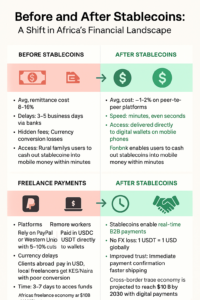In cities across Africa, from Nairobi to Lagos, a quiet transformation is unfolding in the financial lives of millions. No ringing bells, no grand declarations—just digital wallets quietly filling up with a new kind of money: stablecoins. Pegged to the value of fiat currencies like the US dollar, stablecoins have emerged as one of the most compelling use cases of crypto in Africa’s fast-moving fintech landscape.
What makes this story remarkable isn’t just the technology—it’s the timing. As inflation bites, currencies weaken, and remittance costs remain stubbornly high, stablecoins are offering ordinary Africans an alternative: a chance to hold value, transact across borders, and participate in a global economy with fewer barriers.
For many, it’s no longer a matter of speculation or crypto hype—it’s a matter of financial necessity.
A Shift Driven by Need, Powered by Innovation
Stablecoin adoption in Africa isn’t led by traders chasing market spikes. It’s driven by freelancers who need to get paid in a currency that won’t lose value overnight. By families receiving remittances who want the full amount, not what’s left after bank fees. By entrepreneurs importing goods from China and India who prefer settling payments instantly, with no middlemen.
For these users, stablecoins like USDT (Tether), USDC (USD Coin), and even newer entrants like cUSD by Celo offer something local currencies often cannot—stability. In countries where exchange rate swings are a daily reality, the ability to hold digital dollars is proving invaluable.
Ama Serwaa, a co-founder of a Ghanaian edtech startup, puts it plainly: “When we started paying some of our contractors in stablecoins, we saw fewer complaints and faster turnaround. It’s just more efficient.”
What’s enabling this shift is not just demand—it’s Africa’s mobile-first DNA. Most Africans skipped desktop banking entirely. Today, fintech apps, peer-to-peer platforms, and digital wallets are making stablecoins as easy to use as M-Pesa or mobile airtime. Platforms like Fonbnk, Yellow Card, and Kotani Pay are building the on-ramps and off-ramps that let people convert local currency into stablecoins, and vice versa.
This isn’t some distant vision. It’s happening now—in WhatsApp groups where traders coordinate USDT swaps, on job boards where remote work is paid in crypto, and in refugee settlements where aid agencies experiment with blockchain-based disbursements for speed and transparency.
Regulation: Walking the Line Between Innovation and Oversight
 But as with any financial shift, stablecoin adoption comes with big questions—particularly around regulation. Across Africa, governments are grappling with how to manage the rise of crypto assets while protecting financial systems and consumers.
But as with any financial shift, stablecoin adoption comes with big questions—particularly around regulation. Across Africa, governments are grappling with how to manage the rise of crypto assets while protecting financial systems and consumers.
In Nigeria, where crypto trading continues to thrive despite banking restrictions, the regulatory dance is ongoing. The Central Bank has taken a cautious approach, but startups and users continue to innovate through peer-to-peer networks. Meanwhile, the Nigerian SEC has proposed draft guidelines to bring crypto players into a formal framework.
South Africa is ahead of the curve, declaring crypto assets as financial products—an important move that allows for regulation without stifling innovation. In Kenya, the Central Bank has been publicly cautious but acknowledged the role digital currencies might play in future financial inclusion strategies.
Pan-African discussions are also picking up pace. There’s a growing realization that regional harmonization could allow for innovation across borders—especially important given the promise of the African Continental Free Trade Area (AfCFTA), where digital currencies might one day serve as a unifying financial rail.
Also Read: What Google’s Latest Layoffs Mean for Product Innovation at Android, Pixel & Beyond
Still, regulators are right to be wary. The risks are real: loss of monetary control, potential misuse for illicit transactions, and consumer vulnerability in a fast-moving market. But the answer may not lie in blanket bans. Rather, it may lie in co-creation—public-private partnerships, regulatory sandboxes, and regional dialogue that allows innovation to flourish with guardrails.
The Road Ahead: Stablecoins and Sovereignty Can Coexist
What stablecoins are doing in Africa is more than enabling digital payments—they’re reshaping financial identity. They’re allowing a young, mobile, entrepreneurial population to engage with the global economy on their own terms. They’re offering a savings tool in countries where inflation can wipe out purchasing power in weeks. They’re enabling cross-border trade at a scale previously bogged down by bureaucracy and poor infrastructure.
Yes, challenges remain—regulatory clarity, infrastructure gaps, and digital literacy chief among them. But the momentum is undeniable.
Already, there are conversations around African-pegged stablecoins, backed by local currencies or commodities, that could serve as a bridge between monetary sovereignty and blockchain-powered innovation. Central Bank Digital Currencies (CBDCs) are also being explored, and while they serve a different purpose, they point to a future where digital currencies are a core part of the continent’s financial DNA.
Ultimately, Africa’s stablecoin story is still being written—but one thing is clear: it’s not just about technology. It’s about trust, access, and empowerment. And if nurtured wisely, this could be the foundation of Africa’s next great leap—not just into the digital economy, but into a more inclusive, resilient, and globally connected financial future.
Author’s Note
As Africa moves toward a more digital, decentralized future, stablecoins offer a unique opportunity to build financial systems that are not only more inclusive but also more aligned with the realities of life on the continent. This article is part of an ongoing conversation on the future of money, sovereignty, and innovation in Africa. I’d love to hear your thoughts—are stablecoins the financial revolution we’ve been waiting for?
📩 Let’s connect on Linkedin as Nawiri Afrika Blog. 🔗 Interested in featuring this article or partnering for fintech storytelling? Reach out: nawiriafrikatech@gmail.com

5 Comments